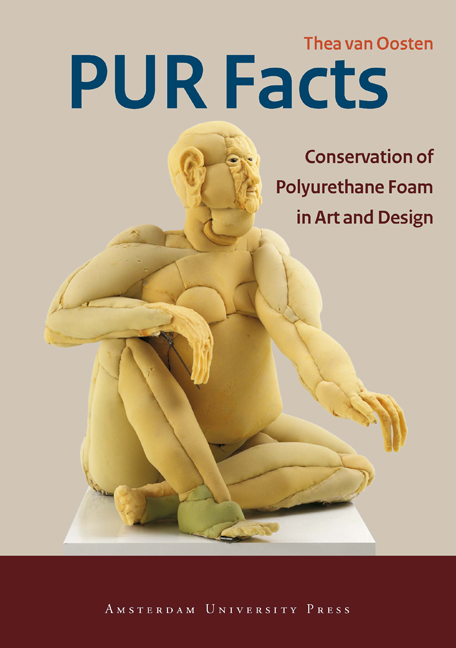Book contents
- Frontmatter
- Contents
- Preface
- Introduction
- 1 Polyurethanes, Manufacture and Applications
- 2 Chemistry, Properties and Degradation
- 3 History of Polyurethane foam Conservation
- 4 Ageing Behaviour of Polyurethane foam
- 5 Assessing the Condition of Polyurethane foam
- 6 Case Studies
- Acknowledgements
- Glossary
- General Information
- Bibliography
- Frontmatter
- Contents
- Preface
- Introduction
- 1 Polyurethanes, Manufacture and Applications
- 2 Chemistry, Properties and Degradation
- 3 History of Polyurethane foam Conservation
- 4 Ageing Behaviour of Polyurethane foam
- 5 Assessing the Condition of Polyurethane foam
- 6 Case Studies
- Acknowledgements
- Glossary
- General Information
- Bibliography
Summary
The adventurous consolidation of a polyurethane ether foam Nature Carpet by Aleth Lorne
The Nature Carpets of Piero Gilardi (Figure 78)
In the 1960s, Piero Gilardi was a young Italian artist nourished by American Pop Art, Italian Arte Povera and European New Realism. These art movements were inspired by industrial production methods and the growing consumption of industrial goods in daily life. Artists belonging to these movements used quick and immediate techniques, and their materials were picked up on the shelves of the supermarket or manufactured objects that they recycled. The work of art placed these objects in a new perspective and in some cases gave them a playful dimension.
In 1965, Piero Gilardi began to make his Nature Carpets from polyurethane foam, playing with the concept of ‘artificial nature’. When asked about the title ‘Still Life of Watermelons’ under which his carpet Angurie was registered at the Boijmans van Beuningen, he answered promptly that a big misunderstanding had taken place. His carpets were not meant to be arranged still lifes but rather ‘cuts’ showing the disorder of nature. Yet they are not realistic because they represent the artist's subjective vision and show how contradictory situations happen by coincidence in nature as in real life. Fresh and dead wood, green and ripe pumpkins, a ripe apple that has dropped in the snow, a dead tree branch amid the waves of the sea: these are some of the recurrent representations in his carpets.
Piero Gilardi's production of polyurethane foam carpets is huge. The polyurethane foam material enabled him to give shape to his visions very rapidly. The fruit and leaves arranged on Gilardi's carpets were made in series, and cut from uncoloured blocks or plates. The leaves were cut using templates, and the clumps of grass were made from a rolled strip of foam. Along one of the strip's edges, narrow triangles were cut off to represent grass blades. The colouration was also carried out en masse. The parts got their first coloured base by being pressed into a paint bath by hand.
- Type
- Chapter
- Information
- PUR FactsConservation of Polyurethane Foam in Art and Design, pp. 91 - 114Publisher: Amsterdam University PressPrint publication year: 2011



